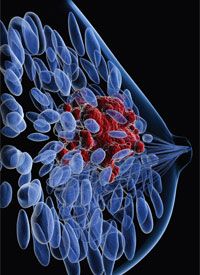Earlier Adjuvant Chemotherapy Benefits Patients With TNBC
Delayed treatment with chemotherapy of more than 30 days after surgery for patients with triple-negative breast cancer is associated with worse survival rates and outcomes than those who receive adjuvant chemotherapy within 30 days of their procedure.
breast cancer

Delayed treatment with chemotherapy of more than 30 days after surgery for patients with triple-negative breast cancer (TNBC) is associated with worse survival rates and outcomes than those who receive adjuvant chemotherapy within 30 days of their procedure, according to findings from a retrospective study performed in Peru presented at the 2018 San Antonio Breast Cancer Symposium (SABCS).1
“In [patients with] TNBC, our results showed that the greater the delay in initiating adjuvant chemotherapy, the worse the outcomes,” said Zaida Morante, MD, of Instituto Nacional de Enfermedades Neoplásicas (INEN) in Lima, Peru, who presented the findings in a press briefing at the meeting. “These results represent a feasible opportunity for improving the outcomes of [patients with] TNBC.”
Prior studies have suggested that a longer time to initiation of treatment following surgery can cause worse overall survival (OS) and worse breast cancer—specific survival for patients with breast cancer.2,3 One of the studies concluded that a longer time to initiation of chemotherapy (TTC) was particularly detrimental for patients with TNBC.3
Guidelines currently recommend starting adjuvant treatment for any form of breast cancer within 4 to 6 weeks of surgery as patients need time to heal from surgery, but the optimal time for initiation of treatment is still unknown.
Investigators conducted a retrospective study of 2007 patients with TNBC who were diagnosed and treated at the INEN between 2000 and 2014. They aimed to evaluate the influence of TTC on survival of patients with TNBC.
Of these patients, 687 patients who had stage I to III TNBC and who had completed adjuvant chemotherapy were included in the analysis. The included patients were divided into 4 groups: those who had a TTC of ≤30 days (n = 189), 31 to 60 days (n = 329), 61 to 90 days (n = 115), and patients with a TTC of ≥91 days (n = 54).
Across the 4 groups, the median age was 48 (range, 21-89). The majority had stage II disease (60.1%) and had undergone a mastectomy (62.9%) compared with conservative surgery. More than half of patients (54.6%) received an anthracycline and taxane-based chemotherapy as their adjuvant treatment.
“We found a statistical association between age, period of time for initiation of chemotherapy, type of surgery, and the type of adjuvant chemotherapy with the time to chemotherapy,” Morante noted.
After a median follow-up of 8.5 years, the estimated 10-year OS rates were 82% in the ≤30 days group compared with 67.4% in the 31 to 60 days group, 67.1% in the 61 to 90 days group, and 65.1% in the ≥91 days group (P = .003).
A statistically significant difference in OS rates by TTC was also noted whether patients were treated from 2000 to 2004 (P = .001), 2005 to 2009 (P = .013), or 2010 to 2014 (P = .064), although no patients treated between 2010 and 2014 had a TTC of 30 days or less.
When viewed according to nodal status, there was also a difference in OS rates whether patients were treated with adjuvant chemotherapy in 30 days or less or more than 30 days. Notably, among patients with N2 or N3 disease, the 10-year OS rate was 87.5% in patients who received adjuvant therapy 30 days or less from surgery and was 68.2% for patients who received chemotherapy more than 30 days after surgery, although this did not achieve statistical significance (HR, 2.065; 95% CI, 0.723-5.899; P = .176).
The 10-year disease-free survival (DFS) rates were 81.4%, 68.6%, 70.8%, and 68.1% for the ≤30, 31-60, 61-90, and ≥91 days groups, respectively (P = .005). Distant DFS rates at 10 years were 80.2%, 64.9%, 67.5%, and 58.6%, respectively.
By multivariate analysis, the risk for death was increased for patients who initiated chemotherapy between 31 and 60 days after surgery compared with 30 days or less (HR, 1.94; 95% CI, 1.243-3.034; P = .004), and when patients had a TTC of between 61 and 90 days following surgery, the risk increased 2.4 times (95% CI, 1.402-4.265; P = .002).
“We can see that the time to adjuvant chemotherapy is an independent prognostic factor for overall survival,” Morante said.
She added that the results could have been impacted by the fact that there were more stage II and III patients in this analysis than in previous studies, and perhaps earlier-stage patients are able to wait longer to receive chemotherapy.
The moderator of the session, Carlos Arteaga, MD, SABCS co-director and director of the Harold C. Simmons Comprehensive Cancer Center at UT Southwestern Medical Center, noted that more patients in the United States would be treated within 30 days of surgery based on current practices.
“I wonder whether this is also arguing in favor of the use of neoadjuvant, because the adjuvant therapy is not treating the breast in this case—that tumor is gone, it’s operated—it’s treating the systemic disease,” Arteaga concluded. “I wonder whether this is arguing further…that we need to have an impetus to deliver the systemic therapy as soon as we can, early, even before the operation.”
References
- Morante Z, Ruiz R, Ku GC, et al. Impact of the delayed initiation of adjuvant chemotherapy in the outcomes of triple negative breast cancer. In: Proceedings from the 2018 San Antonio Breast Cancer Symposium; December 4-8, 2018; San Antonio, Texas.
- Gagliato de M, Gonzalez-Angulo AM, Lei X, et al. Clinical impact of delaying initiation of adjuvant chemotherapy in patients with breast cancer. J Clin Oncol. 2014;32(8):735-744. doi: 10.1200/JCO.2013.49.7693.
- Chavez-MacGregor M, Clarke CA, Lichtensztajn DY, Giordano SH. Delayed initiation of adjuvant chemotherapy among patients with breast cancer. JAMA Oncol. 2016;2(3):322-329. doi: 10.1001/jamaoncol.2015.3856.



